AWS Rekognition
Overview
The extremely well-liked AWS Web Services offers a deep-learning-based solution called AWS Rekognition (AWS) which makes it simple to add video and image analysis to your applications. It is also utilized for identification, research, and authentication in a variety of businesses.
What is AWS Rekognition?
AWS Rekognition makes it simple to include image and video analysis into your apps. Upload an image (or) video to the AWS Rekognition API, and the service will recognize objects, people, text, scenes, and activities. It may also identify any inappropriate material. AWS Rekognition can also perform accurate facial analysis, face comparison, and search. Faces can be detected, analyzed, and compared for user authentication, cataloging, people counting, and public safety applications.
AWS Rekognition is built on the same tried-and-true, highly scalable deep learning technology that AWS's computer vision experts use to analyze billions of photos and videos daily. It does not require any machine learning knowledge to utilize. AWS Rekognition features a straightforward API for fast analyzing of any picture or video content stored in AWS S3. It always learns from new data, and we're constantly updating the service with new labels and face comparison features.
AWS Rekognition Features
-
Label Recognition: AWS Rekognition streaming video events is a low-cost, low-latency, fully managed service that detects items in real-time such as people, dogs, and shipments. AWS Rekognition streaming video events deliver the identified entity, such as a person, pet, or parcel, as well as the bounding box coordinates, a zoomed-in picture of the discovered object, and the date. You may send timely and actionable warnings when the required object is spotted.
-
Face Analysis: AWS Rekognition streaming video events can recognize and search for faces in real-time in your live video feeds. You may run a face search against a repository of your photographs with extremely low latency by using a stream from AWS Kinesis Video Streams as an input to Rekognition Video.
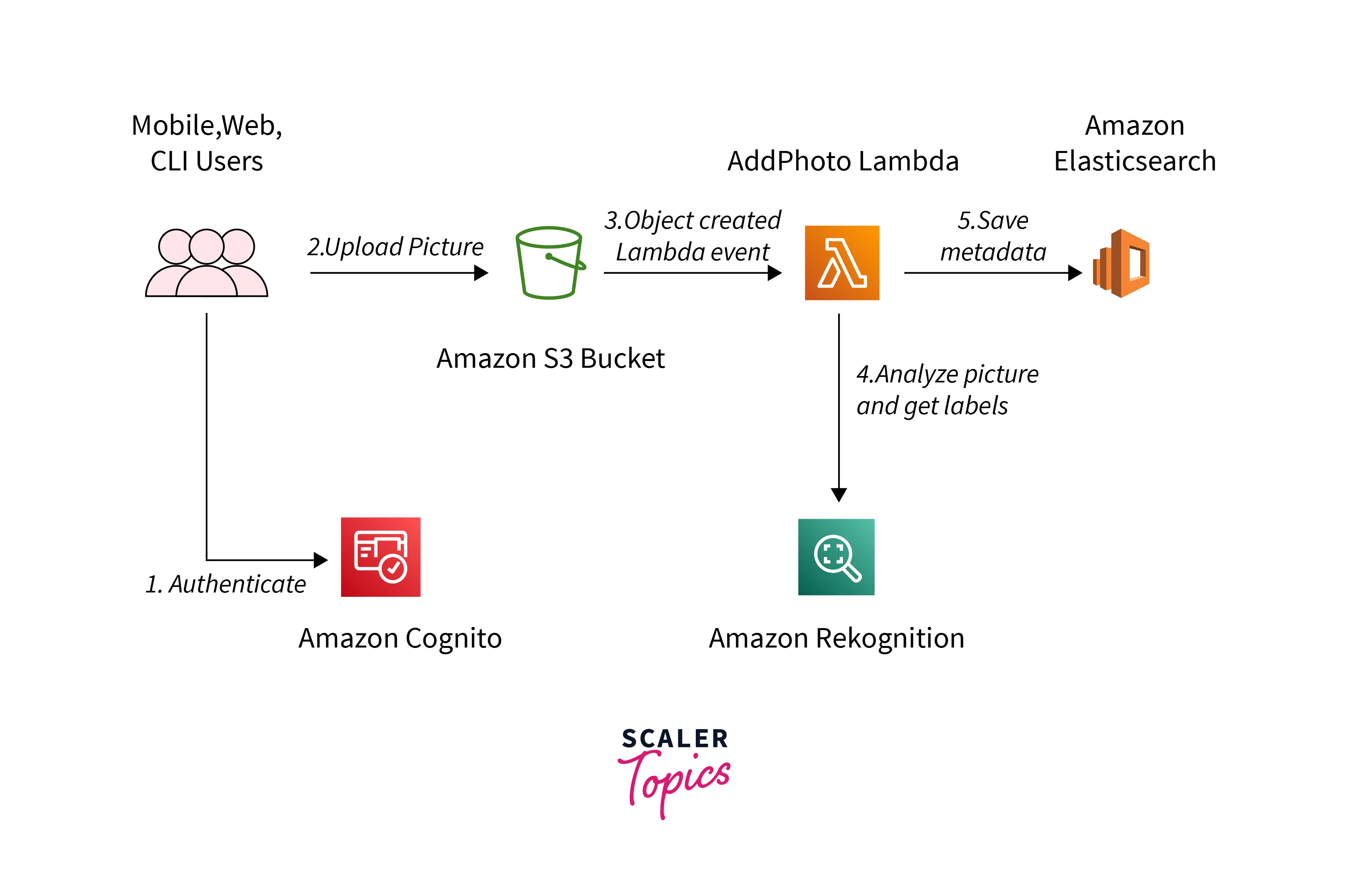
-
Detection of Objects, Scenes, and Activities: AWS Rekognition Video recognizes thousands of things like automobiles or dogs, sceneries such as a city, beach, or wedding, and actions such as package delivery or dancing. Object bounding boxes are provided for specific objects such as 'Person' and 'Car,' allowing counting and object localization.
-
Text Recognition: AWS Rekognition Video finds and interprets the text in videos automatically, providing detection confidence, a location bounding box, and a timestamp for each text detection. Furthermore, you may filter words by regions of interest (ROIs), word bounding box size, and word confidence score.
-
Celebrity Identification: You may use AWS Rekognition Video to identify and recognize when and where well-known people appear in a video. The time-coded output contains the celebrity's name and unique id and URLs connecting to associated material for the celebrity, such as the celebrity's IMDB link.
-
Face Recognition and Analysis: AWS Rekognition Video can recognize and return the bounding box position for up to 100 faces in a video frame. You may also acquire additional information for each recognized face, such as gender, emotions, approximate age range, and whether the individual is smiling, as well as timestamps for each detection.
-
Face Examination: It searches a proprietary bank of face photos to identify recognized persons in a video. Each match receives a similarity score and timestamps for each incident where the same individual is detected within the video. AWS Rekognition Video may additionally cluster all unknown persons in a video with no matches in the repository and produce timestamps with unique identifiers for each.
-
Person Mobility: You may use AWS Rekognition Video to record where, when, and how each person in your video moves. AWS Rekognition also gives a unique index for each individual discovered, allowing you to count how many people are in the video.
-
Detection of Objects and Scene: The Rekognition picture recognizes hundreds of things, including cars, dogs, and furniture. Scenes in photos, such as a sunset or a beach, are also detected by rekognition. This lets you quickly search, filter, and curate vast picture collections.
-
Comparison of Face: Rekognition Image calculates the odds that two photographs of the same person include the same face. AWS Rekognition may use the similarity score to validate a user against a reference photo in near real-time.
-
Detection of Risky Images: Rekognition Image allows you to recognize sexual and suggestive information in photos to filter them depending on your application needs. AWS Rekognition gives a hierarchical list of labels with confidence scores, allowing for fine-grained control over which pictures are permitted.
-
Moderation of Content: Amazon Rekognition Video recognizes inappropriate material in videos such as nudity, violence, or weaponry and offers timestamps for each detection. A hierarchical collection of labels with confidence scores identifying sub-categories of dangerous material is also provided. 'Graphic Female Nudity,' , for example,, is a sub-category of 'Explicit Nudity.' Confidence scores and comprehensive labels enable you to create various business rules to meet the compliance requirements of multiple markets and locations.
-
Celebrity Identification: Thousands of renowned, notable, or influential figures in their profession are detected and recognized by the Rekognition picture. This enables you to index and search for celebrities in digital picture collections based on your marketing and media requirements.
-
Management via API, Console, or Command Line: The Amazon Rekognition API, AWS Management Console, and the AWS command-line interface may all be used to access Amazon Rekognition (CLI). The Rekognition APIs can identify labels, analyze faces, compare faces, and discover a face via the console, API, and CLI. AWS Lambda provides Rekognition blueprints that make it simple to start image analysis based on events in your AWS data storage, such as Amazon S3 and Amazon DynamoDB.
-
Image with Text: You can quickly detect and extract text from photos with AWS Rekognition Image, including text in natural landscapes like road signs or license plates, writing over items such as t-shirts or mugs, and text on screens such as subtitles or headlines.
-
Detection of Personal Protection Equipment (PPE): AWS Rekognition Image can recognize whether people in pictures are wearing personal protective equipment (PPE) such as face masks, hand shields, and helmet shields, as well as whether the PPE covers the correct body part (nose for face covers, head for head covers, and hands for hand covers).
-
Administrative Safety: AWS Identity and Access Management are linked with AWS Rekognition (IAM). IAM rules may be used to manage resource-level permissions and regulate your account access to the AWS Rekognition API.
-
Human Evaluation: AWS Rekognition integrates directly with AWS Augmented AI (AWS A2I), allowing you to add human evaluations for dangerous picture identification. AWS A2I includes a built-in human review mechanism for picture moderation, allowing AWS Rekognition predictions to be readily evaluated and confirmed. You may utilize Amazon A2I to access a pool of reviewers inside your business or a workforce of over 500,000 independent contractors conducting machine learning jobs via Amazon Mechanical Turk. You may also employ AWS-prescreened workforce providers for quality and adherence to security measures. See the Amazon A2I website and Amazon A2I Integration with Amazon Rekognition in the Amazon A2I developer handbook for further information on creating human review procedures.
-
Make Data Labeling Easier: The AWS Rekognition Custom Labels dashboard provides a visual interface for quickly and easily identify your photos. With a simple click-and-drag interface, you may apply a label to the entire picture or locate and name individual items in photos using bounding boxes.
-
Automated Machine Learning: Building your personalized model requires no machine-learning experience. Rekognition Custom Labels contains AutoML features that handle machine learning for you. AWS Rekognition Custom Labels can automatically load and evaluate the data, choose the best machine-learning techniques, train a model, and offer performance metrics after the training pictures are delivered.
-
Model Assessment, Inference, and Feedback have been simplified: Evaluate the performance of your unique model on your test set. You can see a side-by-side comparison of the model's prediction vs. the label assigned for each image in the test set. You may also look at performance measures like precision/recall, f-score, and confidence scores. You may immediately use your model for image analysis or iterate and retrain new versions with more photos to enhance performance. After you use the model, you track your predictions, rectify any errors, and utilize feedback data to retrain new model versions and improve performance.
Benefits of AWS Rekogniton
Incorporating powerful image and video analysis into your apps - To utilize AWS Rekognition's trustworthy image and video analysis, you don't need any computer vision or deep learning experience. You can quickly incorporate image and video analysis into any web, mobile, or connected device application by using the API.
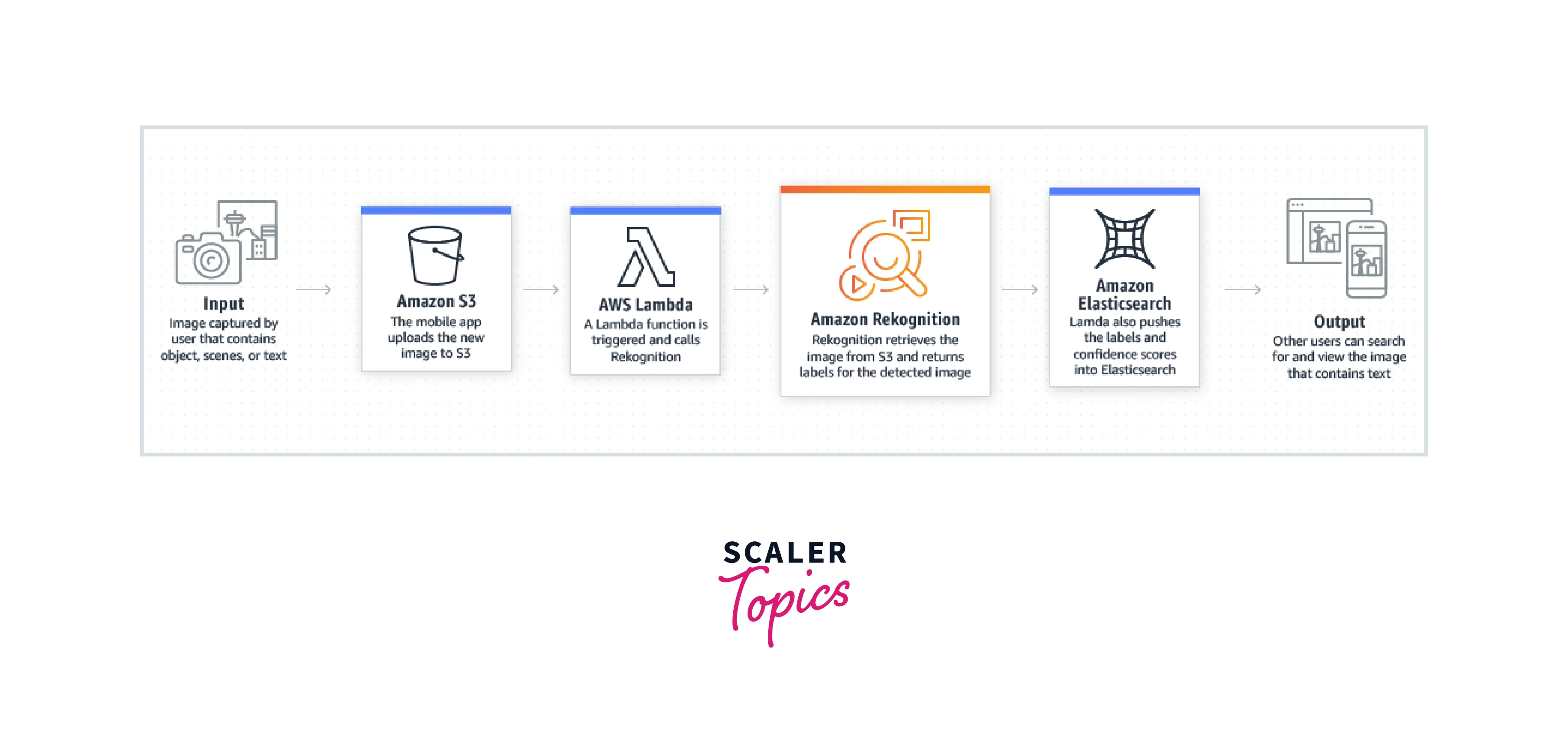
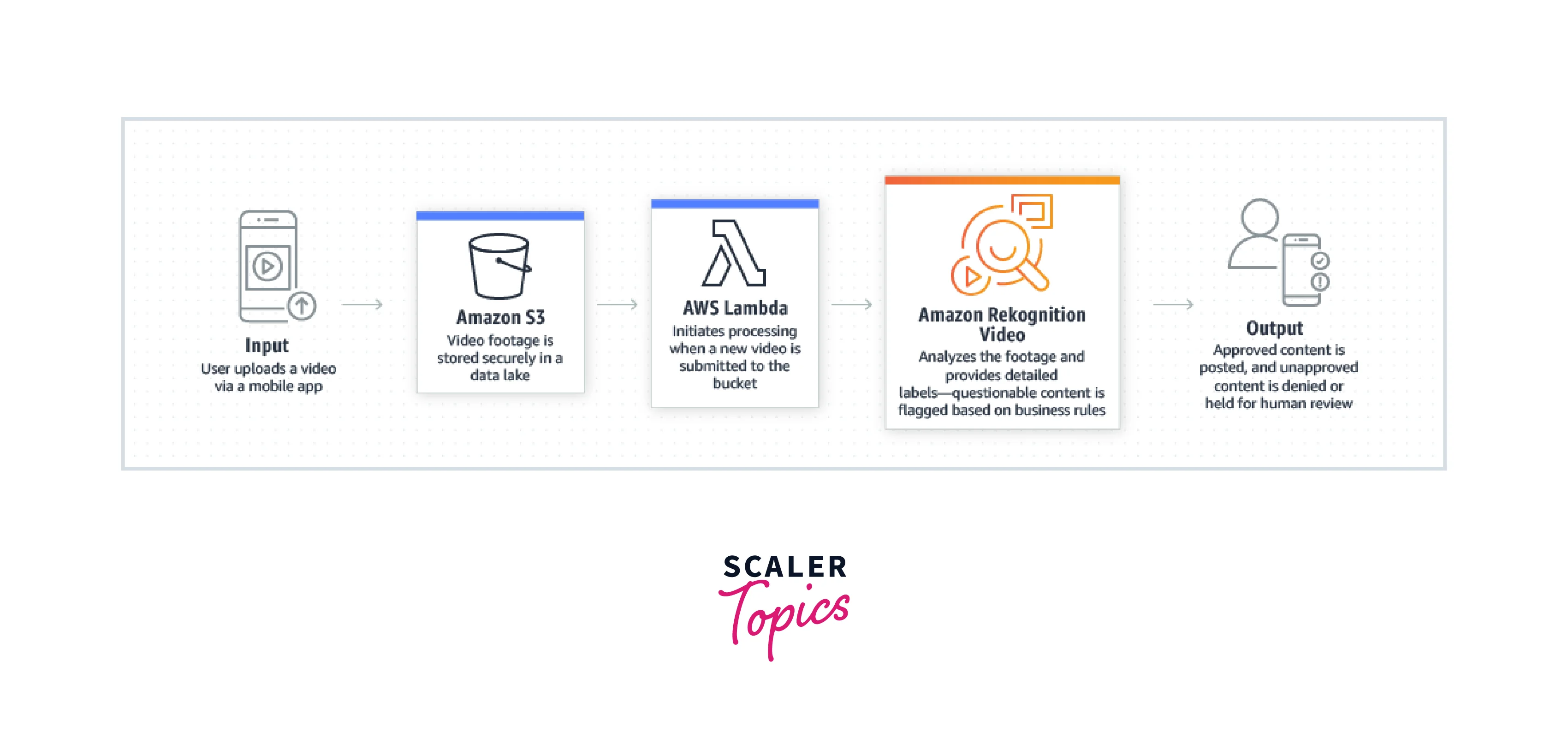
-
Photos and Video Analysis: AWS Rekognition uses deep-learning technology to analyze photos reliably, discover and compare faces, and detect objects and scenes in your photographs and videos.
-
Scalable Photos Analysis: AWS Rekognition analyzes millions of photos, allowing you to manage and organize vast volumes of visual data.
-
Interoperability: AWS Rekognition is intended to function in tandem with other AWS services, such as AWS S3 and AWS Lambda. In response to AWS S3 events, you may directly contact the AWS Rekognition API from Lambda. Because AWS S3 and Lambda expand dynamically in response to the demand for your application, you may create scalable, cost-effective, and dependable image analysis apps. , For example,, when a guest comes to your home, your door camera may upload a snapshot of the visitor to Amazon S3. This launches a Lambda function that identifies your visitor using Amazon Rekognition API operations. Without needing to load or relocate the data, you may do an analysis immediately on photos saved on Amazon S3.
-
Low Price: You pay AWS Rekognition for the photos and videos you analyze and the face metadata you save. There are no minimum costs or obligations required. With the AWS Rekognition tiered pricing model, you can get started free and save more as you expand.
How AWS Rekognition Works?
AWS Rekognition provides two API sets. You use AWS Rekognition Image for analyzing images and AWS Rekognition Video for analyzing videos.
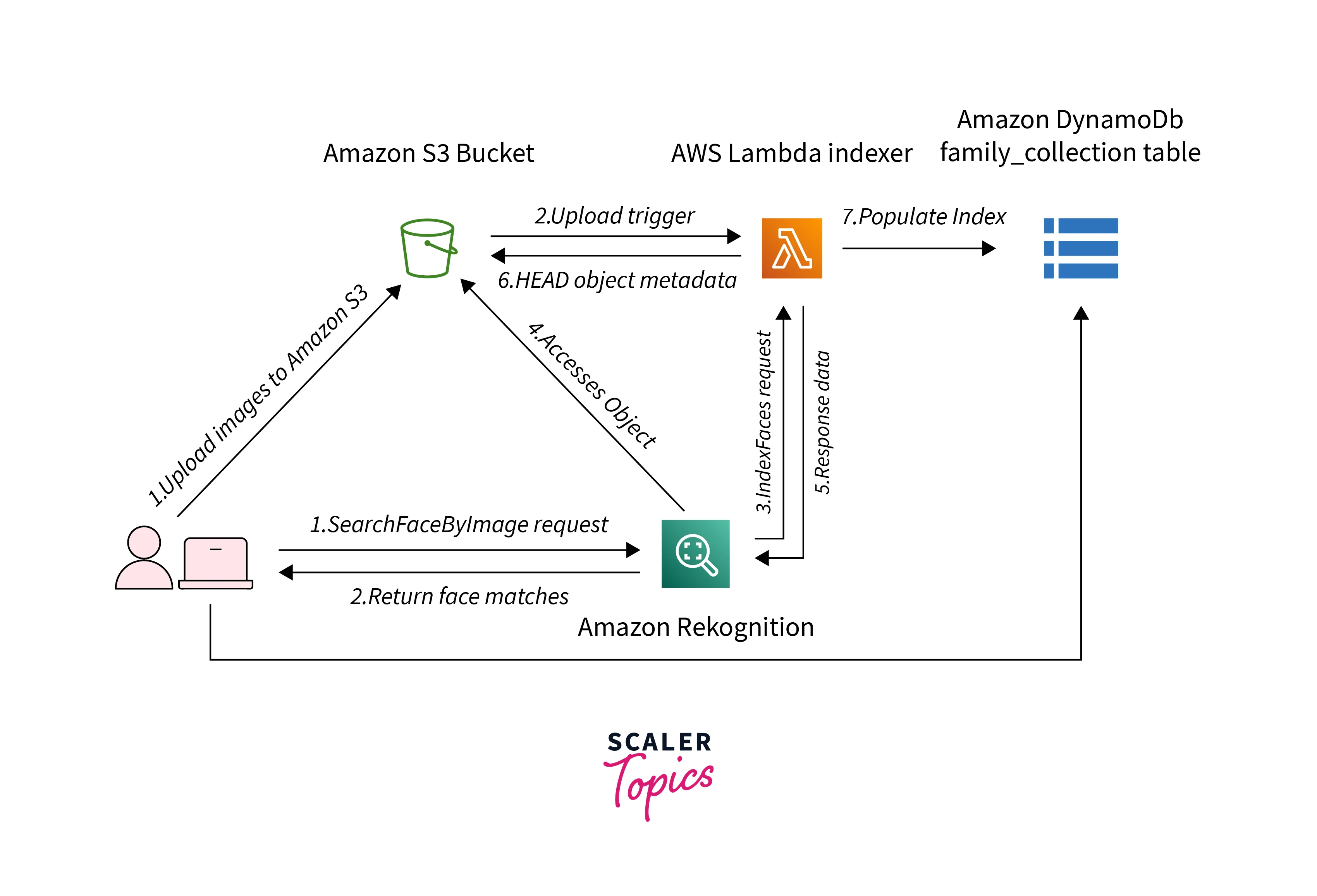
Both APIs analyze photos and videos to produce information that may be used in your apps. You might, , for example,, utilize AWS Rekognition Image to improve the user experience of a picture management application. When a consumer submits a photo, your application may recognize real-world items or faces in the image using AWS Rekognition Image.
After your application is saved, the information from AWS Rekognition Image is returned. The user may search their picture collection for photographs that include a specified item or face. More in-depth queries are conceivable. , For example,, the user might look for faces that are happy or that are a given age.
You may use AWS Rekognition Video to follow the movement of individuals in a video. Alternatively, you may utilize AWS Rekognition Video to search for people whose facial descriptors match those currently saved by AWS Rekognition in a live video.
The AWS Rekognition API simplifies deep learning picture analysis. RecognizeCelebrities, for example, offers information for up to 100 celebrities spotted in a picture. This involves detecting famous faces in the image and locating further details on the celebrity.
Use Cases of AWS Rekognition
Searchable picture and video libraries: AWS Rekognition allows you to search photographs and stored movies to find items and scenarios.
-
Face-based user verification: With AWS Rekognition, your apps can validate user identities by comparing their live and reference images.
-
Personal Protective Equipment Detection: AWS Rekognition recognizes Personal Protective Equipment (PPE) on people in photos, such as face coverings, head covers, and hand covers. PPE detection can be used when safety is of the utmost importance. Construction, manufacturing, healthcare, food processing, logistics, and retail are a few examples. PPE detection may identify whether or not a person is wearing a particular form of PPE. You can use the detection findings to issue a notice or to identify locations where safety is compromised.
-
Demographic and Sentiment analysis: AWS Rekognition interprets emotional expressions such as joyful, sad, or surprised and demographic information from face photos such as gender. AWS Rekognition may analyze photos and send emotional and demographic data to AWS Redshift for periodic reporting on patterns like in-store locations and similar scenarios.
-
Facial Analysis With AWS Rekognition, you may search pictures, save videos, and stream videos for faces that match those in a face collection container. A face collection lists all the faces you possess and manage. In AWS Rekognition, searching for individuals based on their faces needs two key steps:
- Index the faces
- Search the faces
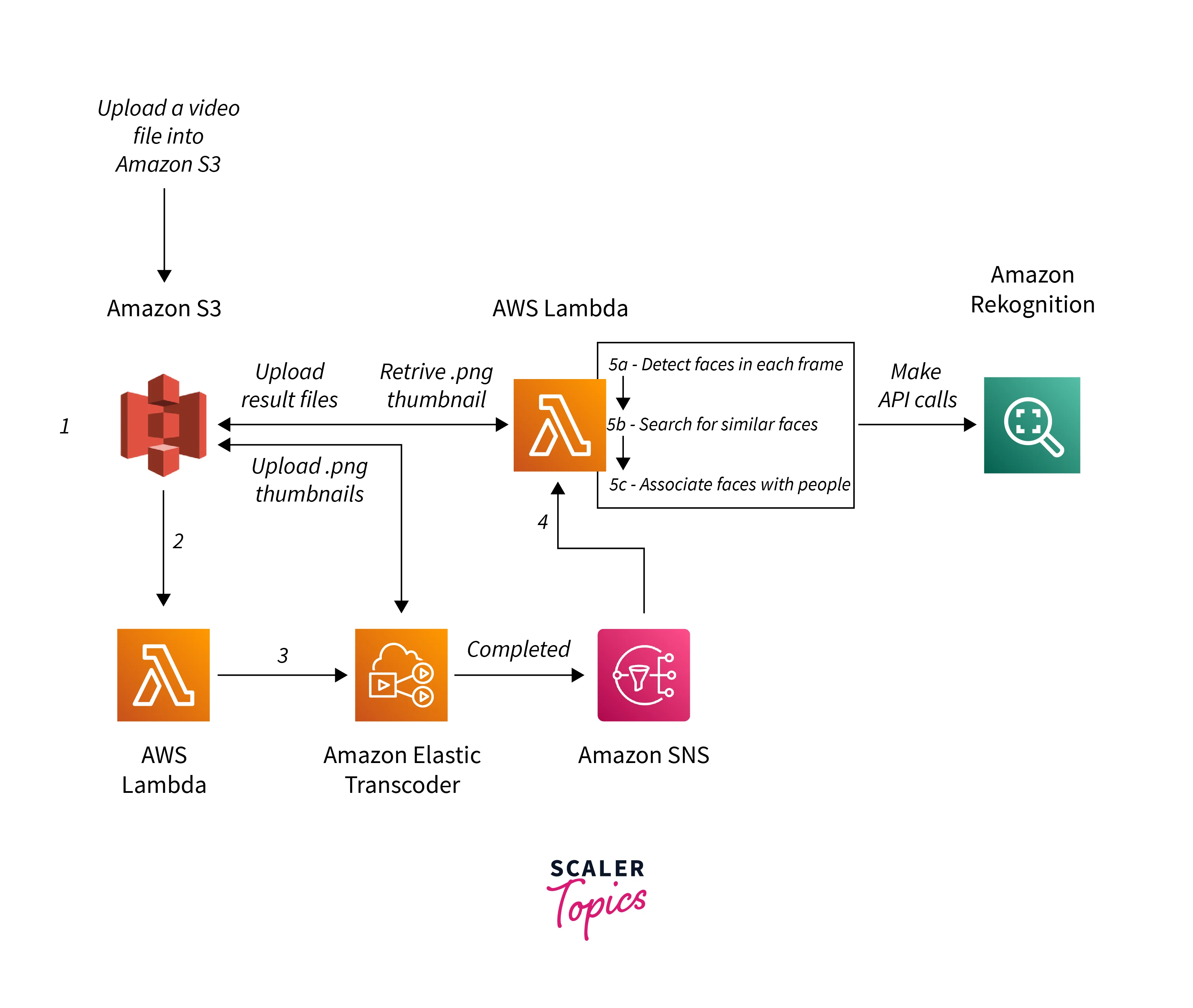
-
Unsafe Content Detection: AWS Rekognition may recognize pornographic and violent material in photos and archived movies. Depending on their business requirements, developers can utilize the returned information to filter unsuitable material. In addition to flagging a picture for the presence of dangerous material, the API produces a hierarchical list of labels with confidence ratings. These labels identify distinct categories of dangerous material, allowing for detailed screening and handling of massive volumes of user-generated information (UGC). Some examples are social and dating sites, photo-sharing platforms, blogs and forums, applications for children's commerce, e-commerce sites, entertainment, and online advertising services.
-
Recognition of Celebrities: AWS Rekognition can recognize celebrities in photographs and videos provided by the user. AWS Rekognition can identify thousands of personalities from various fields, including politics, sports, business, entertainment, and media.
-
Text Recognition: AWS Rekognition Service Text in Image allows you to detect and extract text from images. Most typefaces, especially highly styled ones, are supported by the text in the image. It recognizes text and numerals in various orientations, such as those found on banners and posters. It may be used in picture sharing and social media apps to offer visual search based on an index of photos that contain the exact phrases.
-
Personalized Labels: You may use AWS Rekognition Custom Labels to identify items and situations in photographs that are relevant to your company. You can, , for example,, discover your brand in social media postings, recognize your items on shop shelves, categorize machine components in an assembly line, differentiate between healthy and diseased plants, and recognize animated characters in films.
AWS Rekognition Pricing
AWS Rekognition Video Pricing
AWS Rekognition Picture makes it simple to include image analysis into your apps by leveraging proven, highly scalable deep learning technology that does not need a machine learning experience. You pay for what you use with AWS Rekognition Image. There is no minimum cost or up-front commitment. AWS Rekognition Picture has two costs: the cost of image analysis and the cost of face information storage.
-
Image analysis: AWS Rekognition Image costs you each time you use our APIs to analyze an image. Processing multiple photos is equivalent to running many APIs against a single image. Usage is charged on a tiered price approach depending on the number of pictures processed each month. AWS Rekognition Image APIs are divided into two classes, each with its own cost.
Group 1 APIs include CompareFaces, IndexFaces, SearchFacebyImage, and SearchFaces.
Group 2 includes DetectFaces, DetectModerationLabels, DetectLabels, DetectText, RecognizeCelebrities, and DetectProtectiveEquipment APIs.
-
Face Metadata Storage: To allow face search, you must keep a repository of face metadata objects that AWS Rekognition may search for matches against. Storage fees are assessed monthly and prorated for partial months.
-
Free Tier: You can get AWS Rekognition Image for free as part of the AWS Free Tier. The free tier term lasts a year. Image analysis: During the free tier, you can analyze 5,000 photos per month in Group 1 and Group 2 APIs for free. Face metadata storage: During the free tier time, you can save up to 1,000 face metadata items each month for free.
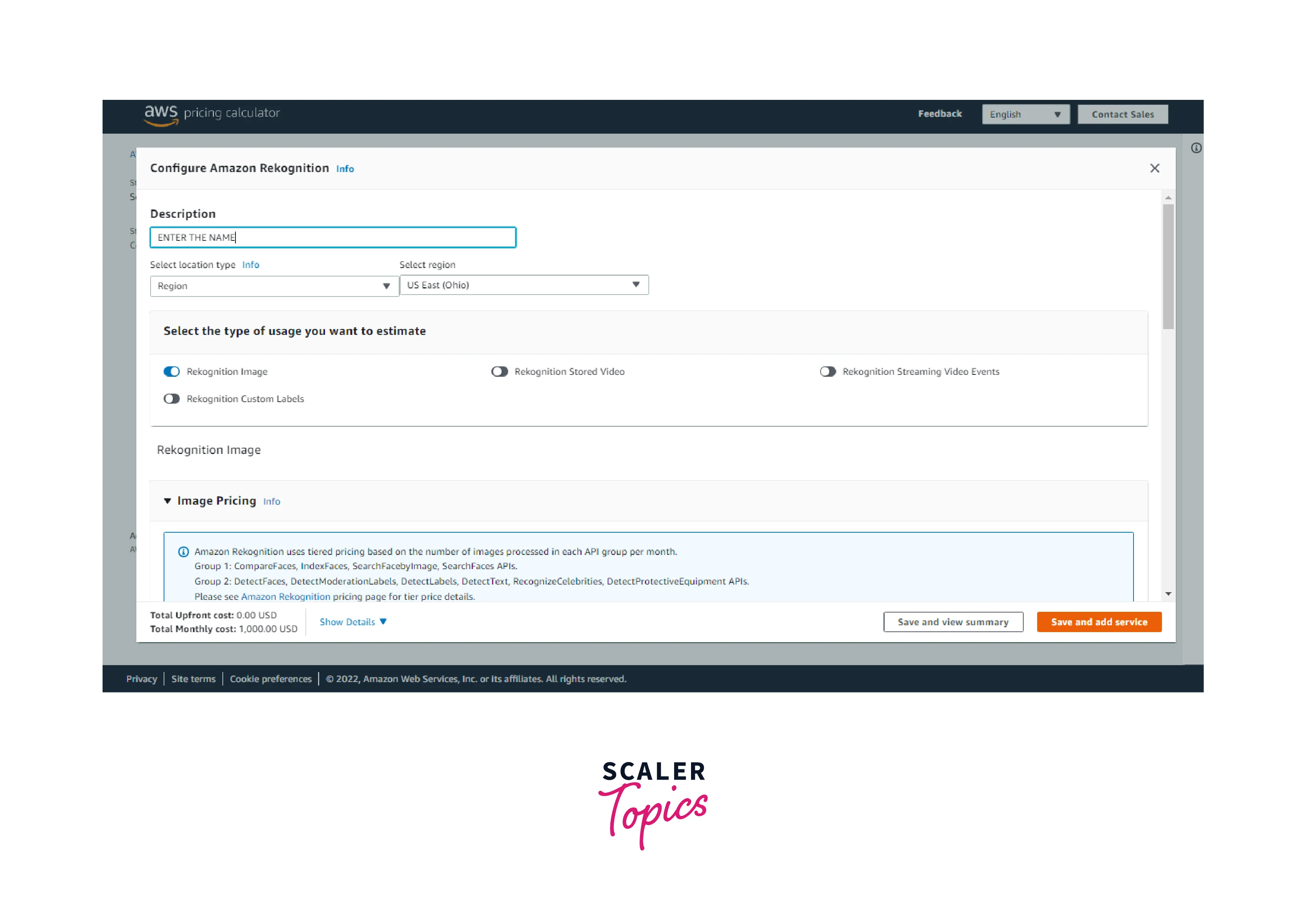
AWS Rekognition Video Pricing
AWS Rekognition Video can analyze both archived video and real-time streaming video events. You pay for what you use with AWS Rekognition Video. There are no resources to be allocated, no upfront charges, and no minimum payments.
Only when you provide the notice to begin video analysis the Rekognition start analyzing the Kinesis Video stream, and it may study up to 120 seconds of video per event. You pay for the amount of footage that AWS Rekognition processes. The AWS Kinesis Video Streams service must be purchased individually.
AWS Rekognition Stored Video Analysis charges you for videos evaluated from AWS S3. You will be charged individually for each API call when executing numerous API calls on the same area of the video.
Face Metadata Storage: To allow face search, you must keep a repository of face metadata that AWS Rekognition may search for matches against. Storage fees are assessed monthly and prorated for partial months.
AWS Rekognition Custom Labels Pricing
You may use AWS Rekognition Custom Labels to identify items and situations in photographs that are relevant to your company. There are two sorts of charges when utilizing Rekognition Custom Labels.
Training Duration: Each hour of training required to develop a custom model using AWS Rekognition Custom Labels incurs a fee. AWS Rekognition Custom Labels may use many computational resources in parallel to train your model faster. This means that the number of hours invoiced may exceed the hours required to train the model.
The number of training hours required to train your model is determined by various factors, including the number of photos and labels in the training set and the machine-learning techniques used to train your model. We've found that 90% of models can be trained in less than 24 hours. Models that need more than 72 hours of training will be automatically eliminated. If your training is automatically ended, you will not be charged.
Inference Duration: Each hour that your trained custom model is available to process photos has a fee associated with it. Several factors, like the size of the processed images and the complexity of the custom model, affect how many photos you can process in an hour.
You can use AWS Rekognition Custom Labels to run many computing resources in parallel to process your images faster. This implies that the number of hours paid may exceed the hours required to run your trained custom model.
Assume you began your inference using your custom model at 2:00 pm and finished at 5:00 pm, and you choose to supply two resources in parallel to analyze your photos. Your total billed inference hours would be 6 hours ().
Free Tier: AWS Rekognition Custom Labels are free as part of the AWS Free Tier. The Free Tier lasts three months and provides ten hours of free training and four hours of free inference every month.
Conclusion
-
AWS Rekognition is a highly scalable deep learning system used by AWS's computer vision researchers daily to analyze billions of videos and images.
-
AWS Rekognition offers two API sets: AWS Rekognition Image for image analysis and AWS Rekognition Video for video analysis. Both APIs process images and videos to generate data that is used in applications.
-
AWS Rekognition streaming video events is a low-cost, low-latency, fully managed service that recognizes items such as people, animals, shipments, and so on in real time.
-
To use AWS Rekognition's dependable image and video analysis, users need not need computer vision or deep learning experience. They can quickly integrate image and video analysis into any online, mobile, or connected device application through API.
-
There are no mandatory minimum costs (or) commitments. You can get started for free with AWS Rekognition's tiered pricing approach and save more as you progress.
